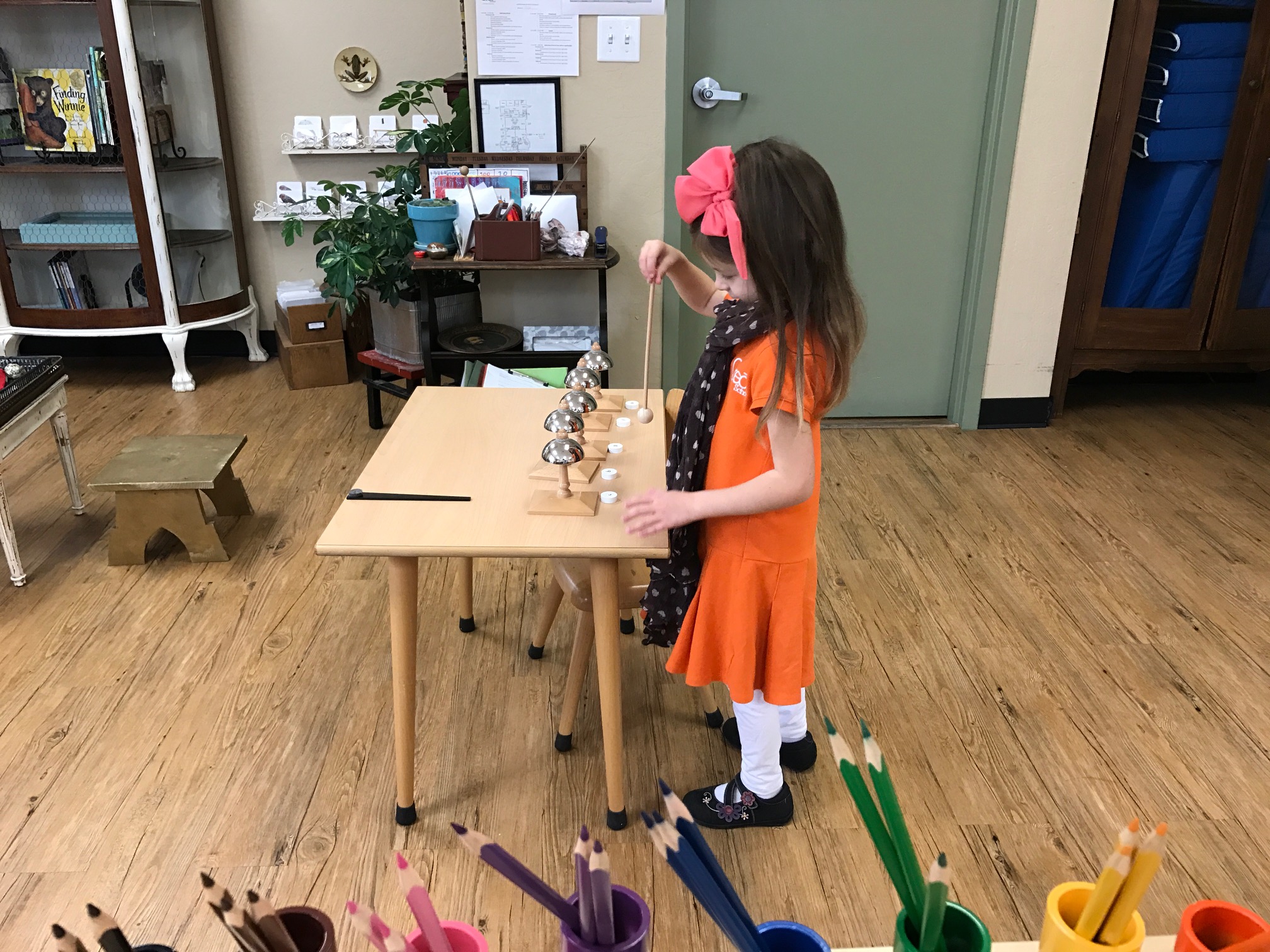Culture in the Children's House
Culture is a nature as adapted by mankind. It is embedded in who we are, what we do, what we say, and how we live. In the Montessori Children's House, culture is deeply rooted in the core areas, such as Geography, Practical Life, Art and Music. The cultural topics spoken to the children are in child’s time and place, and not in terms of History; for instance, the child learns what other children around the world eat or wear. The goal is to assist the process of cultural adaptation and develop the child’s awareness of the oneness of mankind.
Below, we explain how culture is implemented in the Montessori Children’s House and what a huge impact it has on children in their first plane of development.
Music
Human loves music. It is in every culture and society, the language of music is the first language humans learn. The child connects to his environment with music; allowing for expression of emotions with musical instruments is one of the greatest opportunites that can be provided for him. There are so many active music making opprotunities in the Montessori Children's House. Every child needs to be exposed to a variety of musical instruments. Such exposure begins to shape the child's ear for tone. The child learns the tone or the pulse in a music when there is a body percussion. Our body movements, tapping our hands on our laps, or snapping our fingers to the beats can help the child visually see and also hear the rhythm of beats in the melody. Singing is also a great way to use our body as a musical instruments.
Singing, however, is not limited to the group time. Often a child is found singing while working on an activity and is never asked to stop singing because it is not “singing time”. In the Montessori Children's House, the child is exposed to a variety of cultural songs, such as folk songs, foreign songs, songs with high pitch or low pitch. Music in the Montessori Children House is not limited to the 5-10 minute of daily group time. In every environment, there is a music instrument box. The box contains a variety of music instruments such as egg shakers, triangle, maracas, symbols, etc . These instruments can be used individually or in a group. The child gets to listen to the sound each instrument makes freely, analyze it and use it while humming or singing a song. In a group, children pick their favorite instrument from the box and play along while singing a song together. Performing on instruments with others gives the children confidence and provides them opportunities for collaboration with structure.





In the Children's House, one of the first musical activities presented to the child is the Sound Boxes. Sound Boxes contains two sets of six sound cylinders. The child has to shake each sound cylinder and match them in pairs. Later when the child’s ears are attuned to the softness and loudness of the cylinders, the child learns to grade them from the softest to the loudest or vice versa. This activity is known as a direct preparation for the Montessori Bells.
The Bells contain two sets of thirteen bells from Middle C to High C. The set of white bells are known as the control Bells. The mallet is used to play the bells while the damper is used to stop the sound. The first lesson on the Bells are mostly sensorial, giving the child a chance to appreciate the sounds and it continues with language of music. The child who knows the sounds is then shown how to label each Bell, which in turn leads to music composition
“Art is an international language, understood by all.”
Art
Art in the Montessori classroom is all around. It can be found in the flower arraignment that a child creates; the formation of a pattern while a child is working with the graded geometric shapes; the integration of many geometric shapes while working with the metal insets; and the best example of art can be found in the natural beauty of the outdoor environment.
We present artistic beauty the the prepared environment by placing our attention on the small details. The work is attractive, clean and inviting. Fresh flowers and live plants provides a bit of nature indoors. We display the works of many famous artists (artistic media) and we provide different drawing media (tools) for the child to express themselves without adult interference. We teach the children about line and form, proper handling of the drawing media (pen, crayon, pastels, watercolors, chalk, clay) and we step back and allow the child room for self expression.
This self expression maybe in the form of scribbles, lines, shapes, and people or objects in the child’s immediate environment. Inevitably, the child will have so much pride in their work that they will share it with the adult. This is a great honor and we must treat this honor with respect.
In the Children’s House, such honor is treated as such:
Johnny: “Ms Johna, look what I drew!!! Do you like it?”
Take time to handle the item and visually admire it by smiling first without speaking.
Ms. Johna: “Oh Johnny, I see you used many different colors!!!”
or
Ms. Johna: “Oh Johnny, I noticed you were hard at work with your art piece!”
or
Ms. Johna: “Oh Jonny, please tell me about your art piece!”
Avoid praise that places attention on the adult which has the effect of the child producing a product for the pleasure of the adult and place it back on the child and their intrinsic motivation to produce for themselves.





Culture in the Home
Culture can be expressed through different aspects: a process of individual enrichment, groups "particular way of life" and culture as an activity. Because it is nature as adapted by humankind, we must feed and surround the soul of child of 3-6 with culture as it is applicable to them. The child is mostly focused on daily acts of life and adaptation to their time and place. Culture is expression. At home, culture can be incorporated in many ways:
- Cooking foods or experiencing local cuisine from different cultures i.e., Indian, Japanese, Irish, Mexican, Greek, etc.
- Listening to music from different cultures and eras, identifying instruments, attending operas, museums, ballets, concerts, etc.
- Sewing and stitching patterns from different cultures.
- Creating other art from different cultures: weaving, painting, clay modeling, beading, crocheting etc.
- Read books about different cultures that have to do with every day life (things the child can relate to).
“If we all could see the world through the eyes of a child, we would see the magic in everything.”












A Peek inside our Children's House Classrooms
Bobcats
Dear parents,
December was a great month in Bobcats, the children showed great excitement for the amusing seasonal activities they have been experiencing. The Nutcracker Ballet performance has been in fact the highlight of their story telling. We dedicated the last nature walk of the year to acorn picking; the children used the acorns for the Peace Chimes, handmade tokens of love and peace from children to their parents.
The children were thrilled about their holiday plans and few shared the destinations they were going to visit. This led us to learn about the flags of each state; older children enjoyed drawing the flags and making labels for each state.
It is astonishing to see how fast the children are learning Spanish songs and at times count or indicate Spanish words during the day. Ms. Dinora loves to surprise the children with new Spanish songs and the children are getting more comfortable communicating with her. They truly are amazing.
As 2016 has come to an end, we hope everyone had a happy holiday and a Happy New Year. We are looking forward to an incredible year full of joy, health and prosperity for all Creo families.
Warmly
Ms. Mahsa & Ms. Dinora














Cactus Wren
Dear Parents,
How time flies!! It has been a very productive first semester of the school year and we are eager to see what our second semester brings! The children are enjoying the Outdoor Environment. They have been busy gathering the acorns that fall from our two trees for our art project. We have also harvested the radishes which we prepared and shared at snack time. Our tomato plants are full of beautiful green tomatoes. We are anxiously waiting for them to ripen.
Inside, the children are practicing all the new lessons that have been given. We have introduced a few new songs and group games. We are also reading and looking at photos of different cultures around the world. We talk about the clothing, housing, and food of many cultures. It is exciting to see their reaction to the way other children their age live around the world.
Miss Eugenia and I would like to thank all the parents for letting us spend time with your child. We appreciate the energy and love they bring into our lives and the wonderful insights of the world from their perspective that they teach us daily. It is amazing to see and experience all the emotional, social, and academic growth there has been in these few short months. We look forward to the rest of the school year.
With peace and happiness,
Ms. Johna and Miss Eugenia










Gray Fox
Dear Families,
Arizona "winters" are amongst our favorite months as we are able to take full advantage of the Southwestern Arizona Winter. Our nature walks are lengthy, our music, books and work travel outside with us. The children have enjoyed tasting various organic herbs growing in our gardens and the rewards of caring for life on campus.
Along with the sheer beauty of the outdoors, we have been learning songs about winter. The children are identifying the differences between winter-wear versus other seasons. Some of the older children have been learning about different snowflake patterns. In addition to learning about the change of seasons, we have been discussing various cultural occurrences surrounding the changes. Mostly focussing on togetherness, family, celebrations and traditions of life around the globe. Thank you to all who have donated to our Local Food Bank; it is impactful for your child to understand the importance of giving.
As another calendar year has come to a close, we like to reflect on all of the wonderful monuments and melodies written by each child. The amount of pure love and joy your children emanate is noteworthy. The steps toward independence, the effort, the greater understanding of community and connectedness continue to flourish with each passing day. Children are the makers of man; what a wonder and privilege it is to witness the process of peaceful human development unfold.
From the bottom of our hearts, we thank you for your trust and support over the past several months.
Happy New Year,
Ms. Lauren and Ms. Yadira













